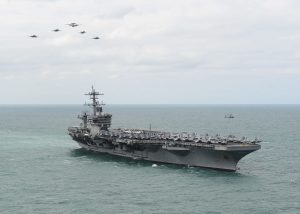A new report out of the Office of the Secretary of Defense suggests that the United States Navy should downsize by two aircraft carriers and use the money thus saved on smaller, lighter combatants. As reported by David Larter, the U.S. Navy would also freeze the size of the force of large surface combatants (cruisers and destroyers) in favor of smaller ships (including frigates and corvettes) and unmanned vessels.
The suggestion that the United States cut two carrier battle groups comes at the intersection of two broad debates. The first involves how to restructure the U.S. Navy for high intensity conflict, and what role aircraft carriers will play in that new structure. While the vulnerability of modern aircraft carriers remains very much in question, their tremendous expense is not. The current force structure invests an immense amount of combat power into a few hulls that can only be in a few places at once. Advocates of force structure reform have long called for a new procurement strategy that would multiply the number of platforms capable of combat, even at the expense of per unit capability. The proliferation of Chinese anti-ship missile systems has driven much of this discussion.
The second (and much more recent) debate investigates how the United States military will manage what may become long-term austerity in response to the economic devastation wrought by COVID-19. To be sure, the OSD report does not appear to have taken the pandemic’s disruptive effect into account, but the proposal to decommission two carriers for strategic reasons will undoubtedly have an impact on how Congress and the Defense Department manage looming cuts to the defense budget.
Removing two carriers from service would force a rethink of the organization and deployment schedule of the entire fleet. Some slack would be taken up by the increasingly effective aviation-centric amphib fleet, but the future of the amphib force is also in some doubt given reforms proposed within the U.S. Marine Corps. In any case, fewer carriers would be available for the “political” component of their mission, which involves deterrent and “show the flag” deployments around the world.
The three carriers retired under this plan would probably include USS Nimitz, the oldest carrier in the fleet, the Eisenhower (second oldest), and USS Harry S. Truman, which is the oldest carrier not to have undergone refuel and overhaul. This would leave seven Nimitz-class carriers in service, along with two Ford-class carriers pending the commissioning of USS John F. Kennedy (CVN-79). Three more Ford-class carriers remain scheduled, and it is unlikely that the Navy will risk the immense loss of human and infrastructure capital that a cancellation of future ships would entail. It is worth noting, however, that the U.S. carrier force would remain substantially larger than the combined fleets of any plausible coalition of enemies.

































